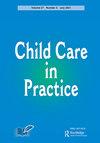英国地方当局对如何防止儿童被看护的看法
IF 1.4
Q3 FAMILY STUDIES
引用次数: 2
摘要
摘要目的20多年来,英格兰地方当局照顾儿童的比率一直在上升。进行这项研究是为了确定地方当局采取了哪些他们认为最有效的方法来防止儿童需要得到照顾。它还考虑了它们如何评估这些方法以及如何评估成本效益。方法对2018年英国儿童社会服务部门领导进行在线调查(n = 152)。调查结果60个(39.5%)地方当局完成了调查。受访者被要求选择三种他们认为最有效的服务或方法,以防止儿童需要接受护理。最受欢迎的是81.7%的人选择的全系统方法,其中最常被引用的是安全标志。其次是边缘护理服务(61.7%)、早期帮助(56.7%)、家庭小组会议(43.3%)、育儿计划(18.3%)、短暂休息服务(15.0%)和“其他”服务(20.0%)。经历过护理儿童数量增加的地方当局更有可能讨论最近推出的方法。全系统方法和养育子女方案是最有可能进行独立评估的方法。虽然大多数地方当局报告称,在评估中使用了经济分析方法,但没有足够的细节来全面评估成本效益。独创性本文描述了儿童服务领导者对旨在将儿童排除在护理之外的方法的当代态度。它还介绍了地方当局评估和评估成本效益的方法。本文章由计算机程序翻译,如有差异,请以英文原文为准。
The Views of Local Authorities in England on How to Prevent Children Being in Care
ABSTRACT Purpose The rates of children looked after by local authorities in England have been rising for more than two decades. This study was conducted to determine what approaches local authorities have adopted that they perceive to be the most effective in preventing the need for children to come into care. It also considers how they evaluate these approaches and how they assess cost-effectiveness. Methods An online survey was distributed to leaders of children’s social services departments in England in 2018 (n = 152). Findings Sixty (39.5%) local authorities completed the survey. Respondents were asked to select up to three types of services or approaches they deemed most effective in preventing the need for children to come into care. The most popular was a whole-system approach selected by 81.7%, with Signs of Safety most commonly cited. This was followed by edge-of-care services (61.7%), early help (56.7%), family group conferences (43.3%), parenting programmes (18.3%), short break services (15.0%) and “other” services (20.0%). Local authorities who had experienced increases in the numbers of children in care were more likely to discuss approaches introduced relatively recently. Whole-system approaches and parenting programmes were the approaches most likely to have had independent evaluations. Whilst most local authorities reported the use of economic analysis methods as part of their evaluation, there was insufficient detail for a full assessment of cost-effectiveness. Originality This paper provides a description of contemporary attitudes amongst leaders of children’s services to approaches that aim to keep children out of care. It also describes approaches taken by local authorities to evaluation and assessing cost-effectiveness.
求助全文
通过发布文献求助,成功后即可免费获取论文全文。
去求助
来源期刊

Child Care in Practice
Nursing-Community and Home Care
CiteScore
3.30
自引率
5.30%
发文量
32
期刊介绍:
Child Care in Practice is a quarterly, peer-reviewed journal that provides an international forum for professionals working in all disciplines in the provision of children’s services, including social work, social care, health care, medicine, psychology, education, the police and probationary services, and solicitors and barristers working in the family law and youth justice sectors. The strategic aims and objectives of the journal are: • To develop the knowledge base of practitioners, managers and other professionals responsible for the delivery of professional child care services. The journal seeks to contribute to the achievement of quality services and the promotion of the highest standards. • To achieve an equity of input from all disciplines working with children. The multi-disciplinary nature of the journal reflects that the key to many successful outcomes in the child care field lies in the close co-operation between different disciplines. • To raise awareness of often-neglected issues such as marginalization of ethnic minorities and problems consequent upon poverty and disability. • To keep abreast of and continue to influence local and international child care practice in response to emerging policy. • To include the views of those who are in receipt of multi-disciplinary child care services. • To welcome submissions on promising practice developments and the findings from new research to highlight the breadth of the work of the journal’s work.
 求助内容:
求助内容: 应助结果提醒方式:
应助结果提醒方式:


